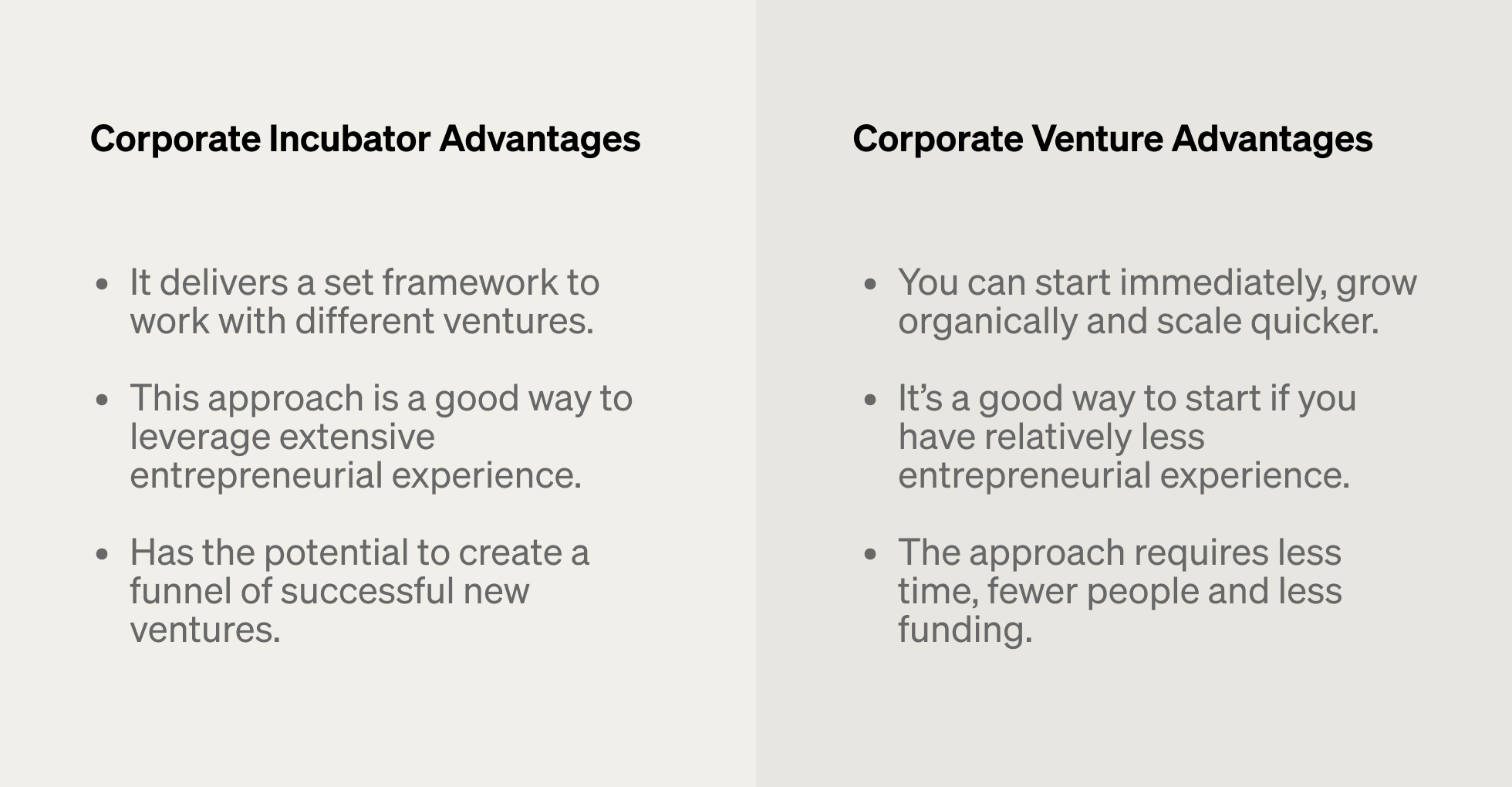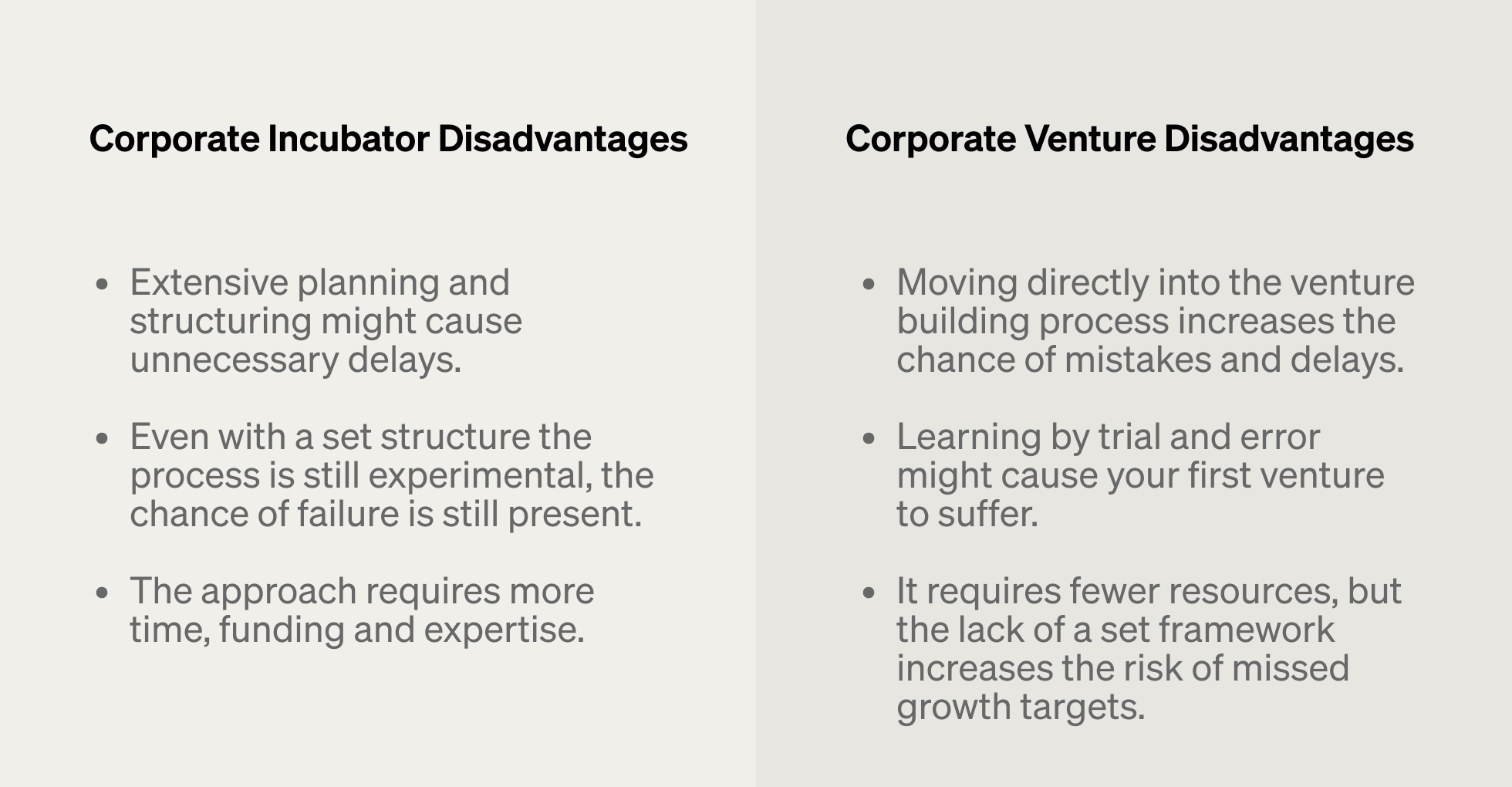Key takeaways
In today’s rapidly changing and highly competitive business landscape, corporate venturing is a cost-efficient and effective way to accelerate growth, create new revenue streams and innovate. The proof is in the pudding, with all top ten S&P 500 companies successfully using the technique to explore new growth areas, gain valuable insights and dominate their industries.
Although the benefits of building your own corporate venturing strategy are virtually endless, it can be daunting if you’re just getting started. One of the first things you’ll have to do is select which corporate venturing technique will best suit your growth goals and targets (there are 16 different techniques to choose from). Many companies start their journey either by building a venture or by setting up a venture building machine A.K.A. corporate incubator.
So, which approach is right for you?
Download our 16 strategies for disruptive innovation by clicking on the link below or explore our global list of corporate ventures with over 200 examples!
Corporate Incubator vs Corporate Venture Building.
Corporate incubators and corporate venture building both fit under the broad term of corporate venturing; as such, they both deliver similar benefits, e.g.:
- Accelerate innovation through corporate ventures.
- Strengthen your ability to compete against new entrants in the market.
- Enable you to experiment with new technologies, business models and offerings.
- Create new revenue streams.
- Establish a structured way of innovating.
Let’s take a look at each definition separately:

Corporate incubators.
Corporate incubators or in-house incubators operate within a corporate setting. They leverage internal assets, talent, networks and other resources to support intrapreneurs in building new ventures from scratch.
The incubator approach essentially creates a framework or program to launch multiple ventures. As such, it requires:
- A general mission or direction (e.g. what types of ventures will it take on?).
- A team of intrapreneurs to provide different venture teams with guidance and support.
- The funding and resources to develop its various ventures.
Samsung’s C-Lab is an excellent example of how corporate incubators can help drive innovation. Through its C-Lab Incubation Programme, Samsung is successfully investing in employee-driven innovation and developing a cutting-edge startup ecosystem.
Corporate venture building.
Instead of focusing on building a program (like a corporate incubator), this approach focuses directly on building a single venture. Teams can immediately cut to the chase, learning as they go and hitting actual milestones a lot faster (e.g. MVP, launch, scale, etc.). It enables teams to start small and gain insights through their own “on-the-job” experiences, operating in a more lean and agile way than with the incubator approach.
A good example is DNB’s Vipps. Their venture quickly turned into Norway’s most popular smart payments app, showing you don’t necessarily need an incubator to produce highly successful results.
The advantages.
Despite their many similarities, these techniques tackle corporate venturing in different ways. Let’s take a look at the different benefits of each approach:

The disadvantages.
Now, let’s take a look at some of the drawbacks of each approach:

Which approach is right for you?
When choosing your approach, it’s essential to consider things like your company’s corporate culture, goals, resources and above all, its level of entrepreneurial experience. For example, if your company is relatively new to corporate venturing, starting small is a good idea. The more adept your team becomes, the more ventures you can take on, eventually even scaling your efforts to build your own in-house incubator.
On the other hand, if your company has a wide range of entrepreneurial experience - starting an incubator is probably the right way to go. Here are just a few of the questions you should consider:
- Does your company have any corporate venturing experience?
- Does anyone on your team have experience working with startups?
- Is there currently any type of venturing process in place (e.g. M&A)?
- Have you developed any internal innovation projects?
The more “YES” answers you have, the better the chance that you can start with a larger incubation programme.
You might also consider creating your own “hybrid” approach, incorporating the best aspects from each of the two mentioned above. For example, instead of starting with one venture, you could start with three, each one exploring a different venture strategy (e.g. one in-house, one with external venture builders, one as an independent spin-off). You can also experiment with different growth areas (e.g. core, non-core and adjacent). This will help you identify which types of ventures best match your corporate goals and culture.
You can even simultaneously design your incubator framework, using the insights gained to build a pipeline of new ventures in the future.
-----
If you’re still not sure which approach is right for you, get in touch for a no-strings-attached chat with one of our partners! At Bundl, we specialise in helping corporations innovate by building the disruptive ventures of tomorrow. We’d love to help you develop yourventure strategy.
16 strategies for disruptive innovation.
These 16 corporate venturing tools will help you innovate at startup speed.








